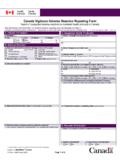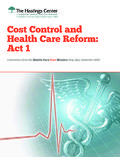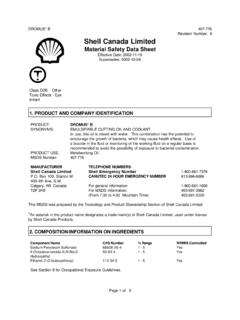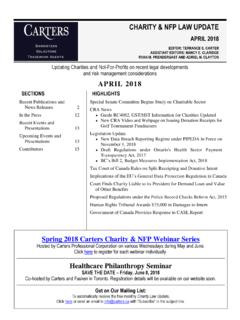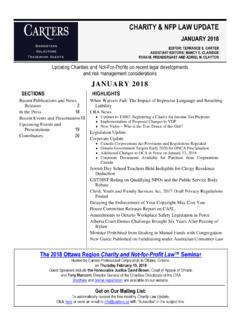Transcription of Pharmaceutical Pricing and Reimbursement Policies in Canada
1 DELSA/HEA/HWP(2006)4 OECD health WORKING PAPERS Pharmaceutical Pricing and Reimbursement Policies in Canada Val rie Paris and Elizabeth Docteur 24 Unclassified DELSA/HEA/WD/HWP(2006)4 Organisation de Coop ration et de D veloppement Economiques Organisation for Economic Co-operation and Development 15-Feb-2007 _____English - Or. English DIRECTORATE FOR EMPLOYMENT, LABOUR AND SOCIAL AFFAIRS health COMMITTEE health Working Papers Pharmaceutical Pricing AND Reimbursement Policies IN Canada Val rie Paris and Elizabeth Docteur This document replaces the initial version of the report that, due to a production error, was missing a text box. This has now been corrected. JT03222006 Document complet disponible sur OLIS dans son format d'origine Complete document available on OLIS in its original format DELSA/HEA/WD/HWP(2006)4 Unclassified English - Or.
2 English Cancels & replaces the same document of 22 December 2006 DELSA/HEA/WD/HWP(2006)4 2 DIRECTORATE FOR EMPLOYMENT, LABOUR AND SOCIAL AFFAIRS OECD health WORKING PAPERS This series is designed to make available to a wider readership health studies prepared for use within the OECD. Authorship is usually collective, but principal writers are named. The papers are generally available only in their original language English or French with a summary in the other. Comment on the series is welcome, and should be sent to the Directorate for Employment, Labour and Social Affairs, 2, rue Andr -Pascal, 75775 PARIS CEDEX 16, France. The opinions expressed and arguments employed here are the responsibility of the author(s) and do not necessarily reflect those of the OECD Applications for permission to reproduce or translate all or part of this material should be made to: Head of Publications Service OECD 2, rue Andr -Pascal 75775 Paris, CEDEX 16 France Copyright OECD 2006 DELSA/HEA/WD/HWP(2006)4 3 ACKNOWLEDGEMENTS The authors wish to thank health Canada for helping to arrange the mission during which much of the information used in this report was collected, for serving as an important source of information, and for commenting on a draft of this report.
3 Particular thanks go to Wayne Lepine, Nelson Millar, Pierre-Gerlier Forest, Edward Gertler, Jean Pruneau, Gina Charos, Etienne Ouimette, Joanne Garrah and Charles Mallory. Thanks are due also to the experts and stakeholders interviewed in the course of preparing this report, many of whom furnished data or publications referenced in the work: Owen B. Adams (Canadian Medical Association), Peter Brenders (Biotech), Ray Chepesiuk ( Pharmaceutical Advertising Advisory Board), Douglas Clark (Industry Canada ), Jeff Connell (Canadian Generic Pharmaceutical Association), Paul de Civita (PMPRB), Heather Davidson (British Columbia Pharmacare), Claude de Stasio (Canadian Life and health Insurance Association), Sylvie Dupont (PMPRB), Mark Ferdinand (Rx&D), David Fortier (Pfizer), Yvan Gaudet (Qu bec drug plan), Andreas Laupacis (CEDAC), Joel Lexchin (York University, Toronto), Micheal McBane ( health Coalition), Lise Matte (Qu bec drug plan), Yves Millette (Canadian Life and health Insurance Association), Steve Morgan (University of British Columbia), Barbara Ouellet (Patented Medicine Prices Review Board), Jeff Poston (Canadian Pharmacists Association), Barry Power (Canadian Pharmacists Association), Mo Sayne (Ontario Drug Benefit program)
4 , Ingrid Sketris (University of Dhalousie), Brett Skinner (Fraser Institute), Philip Schwab (Biotech), Mike Tierney (Common Drug Review, Canadian Agency for Drugs and Technology in health ), Millicent Toombs (Canadian Medical Association), and Angie Wong (Ontario Drug Benefit program). The authors thank Maria Luisa Gil Lapetra and Lihan Wei for assistance in the production of tables and figures included in this report; John Martin, Pierre Mo se, Meghan McMahon and Peter Scherer for their comments and suggestions; and Gabrielle Luthy and Maartje Michelson for secretarial support. DELSA/HEA/WD/HWP(2006)4 4 ABSTRACT This paper describes and assesses Pharmaceutical Pricing and Reimbursement Policies in Canada , considering them in the context of the broader policy and market environment in which they operate, and investigating their role in contributing to Canada s achievements in meeting a range of objectives relating to the Pharmaceutical policy.
5 The federal government regulates prices of patented Pharmaceutical products with the objective of protecting consumers against excessive prices. Regulation has very likely been responsible for bringing Canada s prices for patented medicines roughly in line with European comparators. Prices of generic products, which are not regulated, are relatively high although high penetration of the Canadian market has been achieved. All Canadians have coverage for drugs provided in hospitals through a publicly financed scheme that furnishes hospital and physician services free of charge to patients. Drugs dispensed outside the hospital setting are not included among the insured benefits guaranteed by the Canadian health Act. Consequently, two-thirds of the Canadian population, including most employees and their families, obtains such coverage through private health insurance, while most senior citizens, together with designated groups of vulnerable populations, are covered by provincial, territorial or federal plans.
6 In most cases, patients share in the costs of reimbursed medicines through co-payments or co-insurance, sometimes after meeting a deductible. The lack of protection against the risk of catastrophic out-of-pocket spending for drugs remains an issue for a small part of the Canadian population, concentrated in the Atlantic Provinces. Reflecting these coverage and Reimbursement arrangements, 54% of drug expenditures are financed by private insurances and households. Drug expenditures have been increasing very rapidly in recent years. Formulary management, now facilitated by a government initiative to undertake common drug reviews, and the promotion of generic substitution have been the main levers used by public plans to improve the efficiency of drug expenditures. Private plans have historically covered all medicines authorised for sale in Canada , although this is changing in light of cost pressure.
7 Overall, new drugs are available in the Canadian market on a timely basis, but maintaining comprehensive availability and accessibility may be an emerging challenge. JEL Classification: I18, I11 Keywords: Pharmaceutical policy; Pricing and Reimbursement ; Pharmaceutical market; Canada DELSA/HEA/WD/HWP(2006)4 5 RESUME Ce document d crit et value les politiques de prix et de remboursement des m dicaments au Canada , en les situant dans le contexte politique et l environnement de march dans lesquels elles s inscrivent ; et en observant leur r le dans l atteinte des objectifs relatifs la politique pharmaceutique canadienne. Le gouvernement f d ral r gule les prix des m dicaments brevet s dans le but de prot ger les consommateurs de prix excessifs.
8 Cette r gulation a tr s probablement eu pour effet d amener les prix des m dicaments brevet s canadiens au niveau des prix des pays europ ens auxquels le Canada se compare. Les prix des m dicaments g n riques, qui ne sont pas r gul s, sont relativement lev s malgr une forte p n tration des g n riques sur les march s. Tous les Canadiens sont couverts pour les m dicaments fournis l h pital par un syst me public qui fournit gratuitement tous les services hospitaliers et m dicaux. Les m dicaments dispens s dans le secteur ambulatoire ne sont pas inclus dans le panier des services couverts au titre de la Loi Canadienne sur la sant . Par cons quent, deux tiers des Canadiens, dont la plupart des salari s et leurs familles, obtiennent une couverture m dicament par les assurances priv es, tandis que beaucoup de personnes g es, ainsi que certains groupes vuln rables de la population, sont couverts par des plans publics provinciaux, territoriaux ou f d raux.
9 Dans la plupart des cas, les patients participent aux d penses de m dicaments remboursables selon diverses modalit s (forfait, co-assurance), parfois assorties de franchises. Le manque de protection contre le risque de d penses catastrophiques de m dicament reste un probl me pour une petite partie de la population canadienne, concentr e dans les provinces atlantiques. Refl tant l ensemble de ces modalit s de couverture et de remboursement, 54% des d penses de m dicaments sont financ es par les assurances priv es et les m nages. Les d penses de m dicaments ont augment rapidement au cours des derni res ann es. Le management des listes de m dicaments remboursables, pr sent facilit par une initiative gouvernementale pour entreprendre une valuation centralis e des m dicaments, et la promotion de la substitution par les g n riques, ont t les principaux leviers utilis s par les plans publics pour am liorer l efficience des d penses de m dicament.
10 Les plans priv s couvraient, par le pass , tous les m dicaments autoris s la vente au Canada , mais ceci est en train de changer sous la pression des co ts. Dans l ensemble, les nouveaux m dicaments sont disponibles sur le march Canadien dans des d lais satisfaisants mais le maintien de bonnes conditions de disponibilit et d accessibilit financi re pourrait devenir un d fi. Codes JEL : I18, I11 Mots-cl s : Politique du m dicament ; prix et remboursement ; march pharmaceutique ; Canada DELSA/HEA/WD/HWP(2006)4 6 TABLE OF CONTENTS 3 ABSTRACT .. 4 RESUME .. 5 INTRODUCTION .. 9 1. THE POLICY ENVIRONMENT .. 10 Pharmaceutical product regulatory review procedures and outcomes .. 10 Pricing .. 12 General objectives and scope of Pricing regulation .. 12 Consequences of excessive price .. 14 Impact of Pricing regulation on Canadian drug 15 Coverage of pharmaceuticals .. 17 Forms of drug coverage in Canada .











